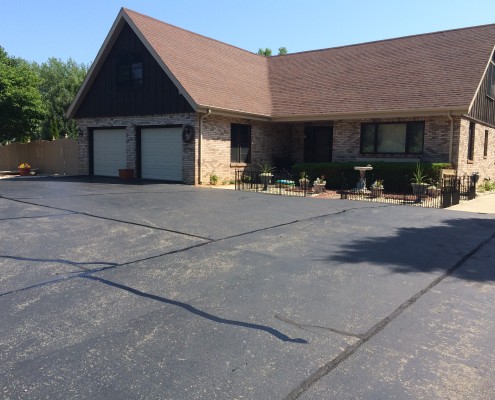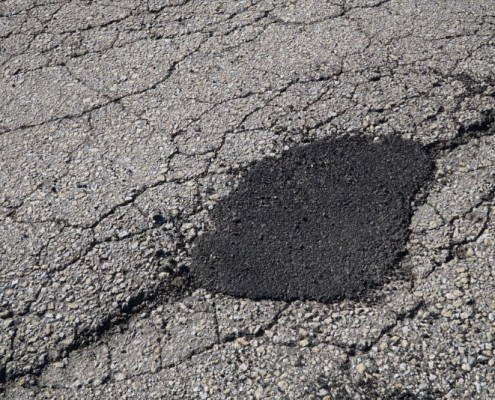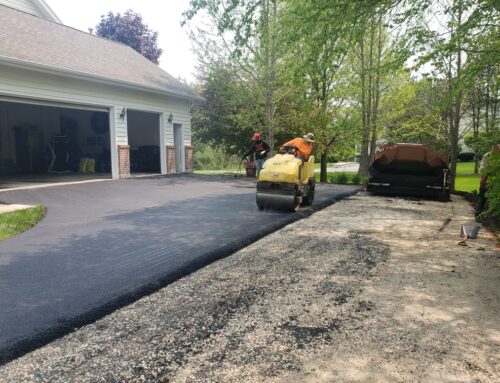ASPHALT PAVING IS EXPENSIVE – MAINTENANCE HELPS YOUR INVESTMENT GO AS FAR AS POSSIBLE
Your pavement will last longer when properly maintained. If you’ve installed a new asphalt driveway or parking lot in the last few years, you know firsthand how much asphalt paving costs, and you’ll want to make sure your investment lasts as long as possible. It takes a little more money to seal your pavement every few years and to have cracks filled regularly, but if you keep up with a regular schedule, you’ll likely avoid more costly repairs like potholes.
There are some problems that cannot be fixed easily with maintenance, like a pavement base that is installed poorly or tree roots growing under your pavement, but good maintenance will delay repairs and repaving for longer. When you take good care of your asphalt, you can avoid damage from water/ice and surface cracking from the weight of vehicles. Keep reading to learn more about essential asphalt maintenance services.
CRACKS
Minor cracks can be repaired easily with a high-grade rubberized crack-fill. The sooner cracks are filled, the sooner they will stop spreading. If the cracks open back up from wear and tear, we can simply fill them again. More severe cracks will likely need to be patched instead. This process is more involved but offers long-lasting results. Common types of asphalt cracks you may see in driveways, parking lots, and roadways include:
There are some problems that cannot be fixed easily with maintenance, like a pavement base that is installed poorly or tree roots growing under your pavement, but good maintenance will delay repairs and repaving for longer. When you take good care of your asphalt, you can avoid damage from water/ice and surface cracking from the weight of vehicles. Keep reading to learn more about essential asphalt maintenance services.
- Fatigue cracking – often caused by overloading or a weakened base, these cracks are connected in a way that resembles an alligator’s skin (hence why they are often referred to as alligator cracking)
- Block cracking – appears as large rectangular cracks on surface areas that experience little to no traffic, they are often caused by extreme temperature changes
- Edge cracking – caused by a lack of support on the outer edges of roadways, these cracks are longitudinal and run close to each other, sometimes meeting or crossing
- Transverse cracking – these cracks run perpendicular to the centerline (so straight across the road), and are most often caused by an existing crack or asphalt shrinkage
- Slippage cracking – slippage cracks are crescent-shaped and occur when there is a problem with the asphalt mix that was used during paving or the bond between pavement layers is poor and cracking under the pressure of vehicles braking or turning on the pavement

SURFACE PROTECTION
The surface of your asphalt driveway or parking lot is exposed most to the elements. Sun, water, ice, salt, oil, and more can all cause extra wear and tear, leading to surface cracks, crumbling, and holes. Most Asphalt Companies recommend sealcoating asphalt pavement every 1-2 years. That’s probably because they only apply one coat of sealant each time. At Armored, we apply two coats of sealant every time, helping you go 3-5 years between seal coatings instead. When you choose a sealcoating contractor for your driveway or parking lot, make sure they have a reputation for client satisfaction.
The best solution for pothole repair is hot mix patching. The damaged pavement will be cut out and removed, the is cleaned, filled with a hot asphalt mix, and then compacted until the surface is smooth and even with the surrounding roadway. In the winter, it is too cold and wet for hot asphalt to spread and cure properly. That’s why you’ll see the cold patch method used during the colder months. That’s when a cold mix of asphalt is dumped in potholes and compacted down. It is only a temporary fix but an easy one to maintain until the weather is good enough for a proper asphalt patch.

POTHOLES
It is rare for potholes to happen out of nowhere. Usually, there has to be a malfunction from the asphalt layers being poorly installed. Most often, cracks appear first. They are exasperated by cold weather when the asphalt expands and shrinks, heavy vehicle traffic, and long-term wear and tear. Winter takes the largest toll on asphalt pavements and that’s why Wisconsin drivers spend winter and the start of spring dodging potholes on the road and in parking lots.
The best solution for pothole repair is hot mix patching. The damaged pavement will be cut out and removed, the is cleaned, filled with a hot asphalt mix, and then compacted until the surface is smooth and even with the surrounding roadway. In the winter, it is too cold and wet for hot asphalt to spread and cure properly. That’s why you’ll see the cold patch method used during the colder months. That’s when a cold mix of asphalt is dumped in potholes and compacted down. It is only a temporary fix but an easy one to maintain until the weather is good enough for a proper asphalt patch.




